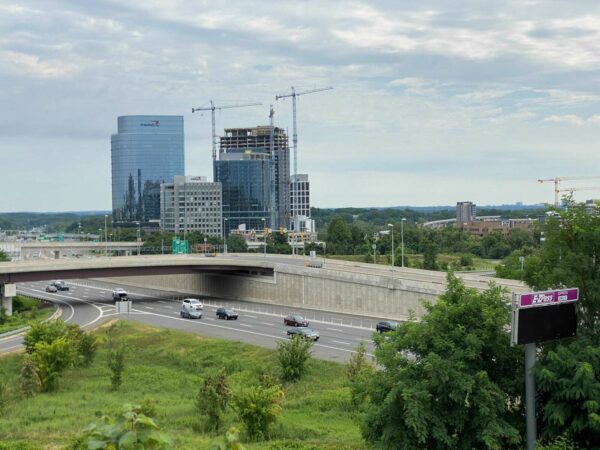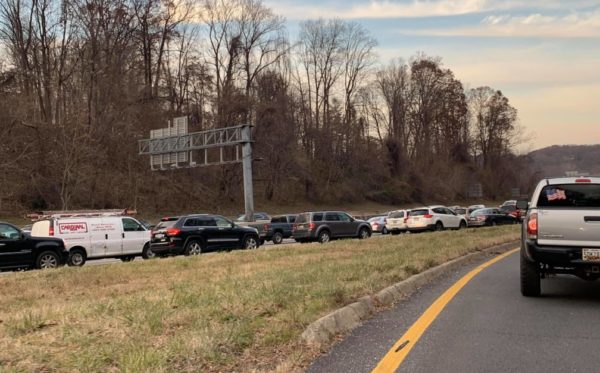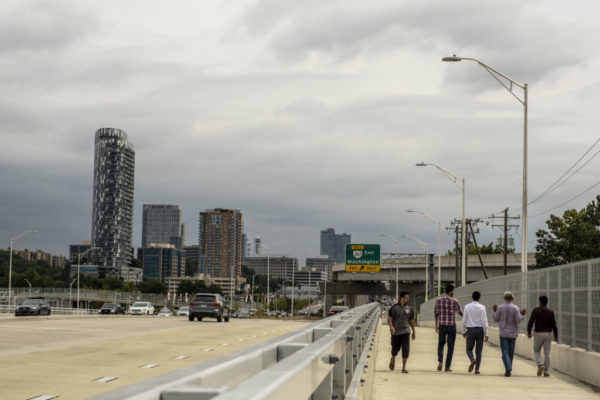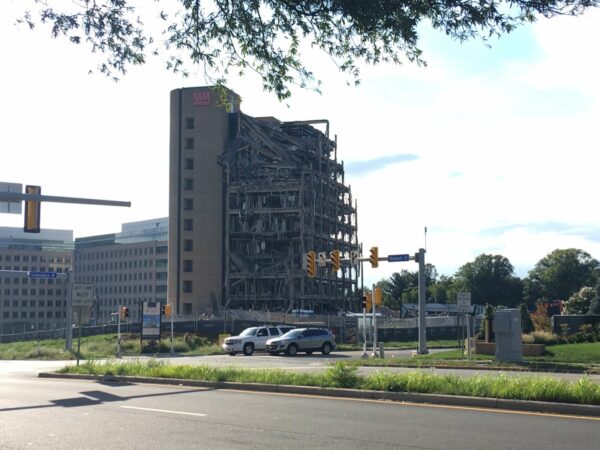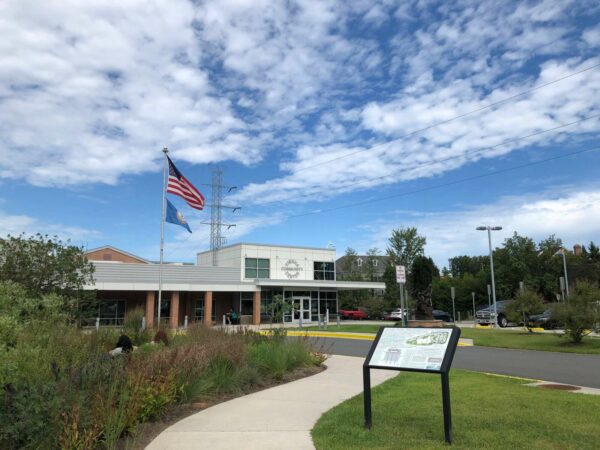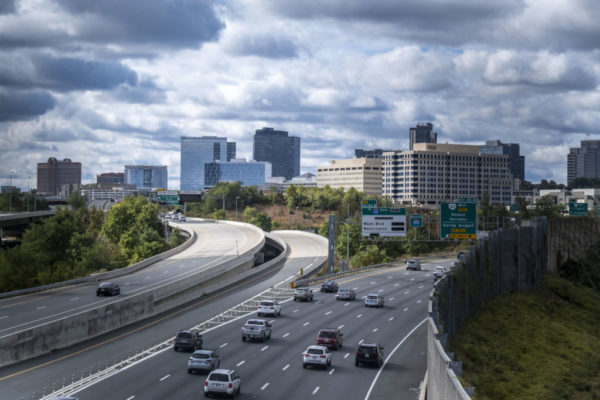Another piece of the I-495 Northern Extension project (495 NEXT) has fallen into place.
Toll lanes operator Transurban has selected the Connecticut-based Lane Construction as the contractor that will design and build 2.5 miles of new express lanes from Tysons to the American Legion Bridge area in McLean, the Virginia Department of Transportation announced yesterday (Tuesday).
Transurban previously worked with Lane Construction on the 395, 95, and existing 495 Express Lanes, according to a press release from the contractor.
VDOT also said that it has executed a comprehensive agreement with Transurban, which operates the existing I-495 Express Lanes that currently stop just north of the Dulles Toll Road.
“This project is the latest extension of the Commonwealth’s 90+ mile express lane network planned for Northern Virginia,” Virginia Secretary of Transportation Shannon Valentine said in the press release. “Through 495 NEXT and the on-going investments in multimodal options, I believe we will unlock one of the most congested highways, significantly improve the region’s transportation network, and contribute to economic growth and opportunity.”
With an estimated cost of $600 million, approximately $440 million of which is for design and construction, 495 NEXT will add two express lanes in each direction as part of an agreement with Maryland aimed at relieving congestion on the Capital Beltway by adding more toll lanes and replacing and widening the American Legion Bridge.
Other elements of the project include:
- Funding for new bus service between Tysons and Montgomery County, including $5.2 million from the state to purchase the vehicles and a $2.2 million annual commitment from Transurban for operations
- Four miles of new bicycle and pedestrian connections, including a shared-use path parallel to I-495 from Lewinsville Road to near Live Oak Drive
- Replacement or rehabilitation of seven bridges with sidewalks, bicycle lanes, and crossings at Old Dominion Road, Georgetown Pike, Live Oak Drive, and Lewinsville Road
- Replacement of nine existing noise walls and the construction of a new noise wall along Live Oak Drive near the George Washington Memorial Parkway interchange
- New storm water management facilities along I-495 and funding for Scott’s Run stream restoration efforts
According to VDOT, the planned bus service across the American Legion Bridge “is projected to move more than 170,000 riders each year and remove 4.7 million passenger miles from the road, reducing greenhouse gas emissions by more than 1,650 metric tons each year.”
VDOT anticipates reaching a financial close for 495 NEXT in December with a final design and the start of construction coming in 2022, despite continued uncertainty about whether Maryland’s toll lanes project will get approved.
Dranesville District Supervisor John Foust, who represents the McLean area, has maintained that VDOT should wait until Maryland gets federal approvals for its project before starting construction on 495 NEXT.
“I believe 495 NEXT should not go forward unless and until Maryland gets approval for its project to increase capacity of the American Legion Bridge and to add lanes on the Maryland Beltway,” Foust said in a statement to Tysons Reporter. “I am disappointed that VDOT and the CTB have decided to go forward without waiting. However, given their decision to go forward, I’m glad they chose Transurban. I have worked with them in the past and I believe they are qualified to deliver the project.”
Initial results from Tysons Reporter’s extremely unscientific poll on the project show a roughly even split between people who completely oppose 495 NEXT and those who decidedly support it, with the former gaining a slight edge. Other respondents indicated that they could support the proposal but have reservations due to the timing or inclusion of amenities for forms of travel other than driving.
By this time next year, the I-495 Northern Extension project (495 NEXT) could be under construction.
The Virginia Department of Transportation secured required federal approvals in July for its $550 million effort to add express lanes on three miles of interstate from Tysons to the American Legion Bridge area in McLean.
With that hurdle surmounted, state transportation officials expect to advance the project fairly quickly over the next year, awarding a design-build contract this winter and finalizing the design next year. Right-of-way acquisitions and construction work could also start in 2022, putting the toll lanes on track to begin operations in 2025.
While traffic volumes are projected to increase roughly the same amount regardless of whether 495 NEXT is implemented, VDOT says extending the I-495 Express Lanes toward the American Legion Bridge will reduce travel times and congestion, moving 2,500 more people per hour through the corridor when they open in 2025.
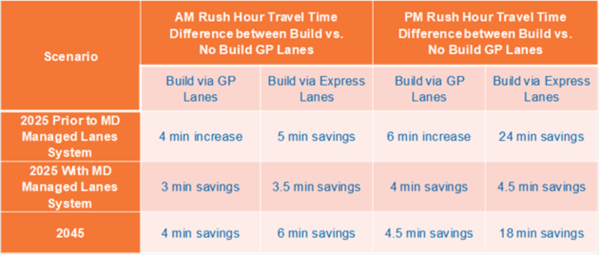
The project also includes transit in the form of new bus service between Tysons and Montgomery County, a trail for bicyclists and pedestrians parallel to I-495, and funds to assist with stormwater management and stream restoration efforts along Scott’s Run.
However, 495 NEXT has encountered some resistance from McLean residents concerned about its potential impact on their neighborhoods, and environmental advocates.
An environmental assessment found that the project will affect 4.11 acres of Scott’s Run Nature Preserve, 19.8 acres of wetlands, and more than two acres of land around George Washington Memorial Parkway, though the Federal Highway Administration (FWHA) and National Park Service (NPS) determined that the effects could be mitigated enough to be outweighed by the benefits.
Some residents and elected officials have questioned whether that would be the case, though, if Maryland’s plans to replace the American Legion Bridge and widen its part of the Beltway fall through, which remains a possibility even after the state approved a pre-development contract.
Now that it’s getting closer to becoming a reality, how do you feel about 495 NEXT?
Would the project make your life easier, or are you more concerned about the inevitable environmental and neighborhood impacts of a major infrastructure project? Should Virginia hit pause until Maryland fully commits?
Chart via VDOT
Plans to extend the I-495 Express Lanes three miles north from the Dulles Toll Road in Tysons to the George Washington Memorial Parkway in McLean are moving full steam ahead.
Now backed by federal approvals, the 495 Northern Extension project (495 NEXT) is on track to develop a more detailed design this fall, Virginia Department of Transportation officials told Fairfax County leaders and community members at separate meetings last week.
With a financial close on a contract projected to come this winter and the design getting finalized next year, VDOT anticipates starting the right-of-way acquisition process and construction in 2022. The new toll lanes are scheduled to open in 2025.
While the project has faced skepticism over whether its benefits will outweigh the impact of construction on the environment and neighborhoods, state transportation officials say expanding the Capital Beltway to the American Legion Bridge — and, ideally, beyond it into Maryland — will provide needed relief at one of the worst traffic bottlenecks in the D.C. region.
“I’ve never heard anyone say the American Legion Bridge is great,” VDOT Chief Deputy Commissioner Rob Cary said during a virtual public information meeting on Wednesday (Sept. 29). “It’s an issue. Everybody knows it’s an issue, and this project is going to move forward and fix that.”
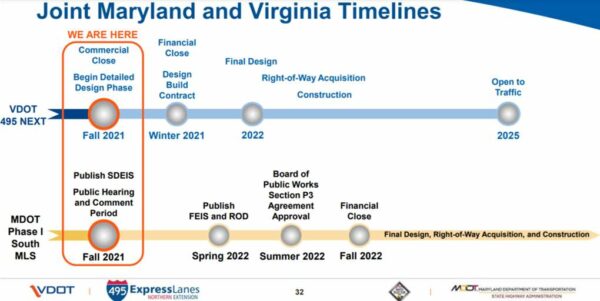
The additional capacity created by the new express lanes will allow for transit across the Potomac River that’s currently stymied by the amount of congestion on and around the bridge, VDOT Northern Virginia Regional Transportation Program Susan Shaw told the Fairfax County Board of Supervisors’ Transportation Committee last Tuesday (Sept. 28).
VDOT has committed to introducing bus service between Tysons and Montgomery County in Maryland as recommended by a study that the Virginia Department of Rail and Public Transportation and Maryland Department of Transportation completed in March.
VDOT will provide $5.2 million to purchase buses, and contracted Express Lanes operator Transurban has agreed to cover the transit service’s operating costs with $2.2 million per year once tolling begins, according to the presentation delivered at both of last week’s meetings.
At Fairfax County’s urging, the state has been looking at the possibility of launching the bus service before the new toll lanes open, especially since Shaw admits conditions “will be degraded some” during construction, which could last into fall 2027, when Maryland expects to open its Beltway toll lanes.
“Those years of degradation are what really concern us,” Providence District Supervisor Dalia Palchik said at the transportation committee meeting. “So, getting ahead on transit and a program to really get people on transit, out of their cars during that congestion, I think, would be very helpful to be successful.”
However, it will be difficult to provide consistent, timely bus service until the express lanes are available, Shaw says. Read More
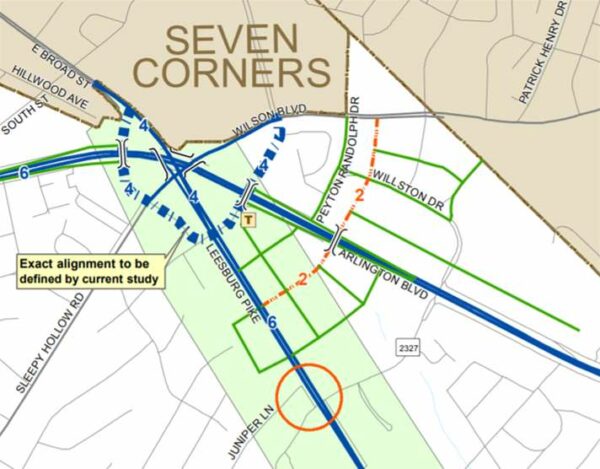
There are few more self-evident testaments in Fairfax County to the shortsighted follies of 20th century land-use planning than Seven Corners.
The groundwork for the confounding convergence of Route 7, Route 50, Sleepy Hollow Road, Wilson Boulevard, and Hillwood Avenue in the Falls Church area was laid before the Civil War. Arlington Boulevard and Leesburg Pike emerged from early county roads that intersected at Fort Buffalo, according to a 2015 article by the Washington Business Journal.
A literal crossroads between Fairfax and Arlington counties and the City of Falls Church, the intersection became more intricate post-World War II, as the area saw a population and development boom, epitomized by the introduction of the Seven Corners Shopping Center, once the largest mall in the D.C. region.
According to The Washington Post, traffic was already a “major headache” in the early 1950s, and “state and local governments spent millions to alleviate” congestion when the mall opened in 1956. But conditions have kept deterioriating despite a patchwork of fixes implemented since then, including the addition of the Route 50 overpass near Patrick Henry Drive in 2009.
“It’s too complex. If you drive through now, you get stuck, everybody blocks each other, it doesn’t work,” Mike Garcia, the Fairfax County Department of Transportation’s planning section chief, told Tysons Reporter last week. “They’ve gone through and adjusted the signals many times. They’ve got it about as good as they’re going to get it.”
The Project
Since inverting time to undo this knot isn’t an option, Fairfax County is now trying to at least loosen it, and this time, it is willing to take the time to hopefully do it right.
As part of a larger package of funding requests, the Board of Supervisors voted on Sept. 14 to authorize transportation staff to seek $94.8 million from the Northern Virginia Transportation Authority for the first phase of a “ring” road that will eventually connect the west side of Route 7 to Wilson Boulevard.
The Seven Corners Ring Road project dates back to 2014, when a visioning task force charged with identifying possible land use and development improvements for the neighborhood recommended including the concept in a comprehensive plan amendment that the county board adopted on July 28, 2015.
According to Garcia, the county and task force considered six different options for improving the interchange, but they ultimately determined that a circular road looping through each of the main streets to create more traditional four-way intersections would be most effective.
“[It] would help at least clear up the area and make it a little more understood from the driver’s perspective, but also understood from the walking and biking perspective as well, because that’s as much the issue that we wanted to solve,” Garcia said. Read More
The Capital Beltway will have slightly less room to accommodate drivers in Tysons this weekend, with construction work shutting down one lane starting tonight (Friday).
The Virginia Department of Transportation announced yesterday (Thursday) that it will close the right general purpose lane on southbound I-495 over the Dulles Toll Road (Route 267) from 10 p.m. today to 5 a.m. Monday (Sept. 27) for bridge joint work.
The Beltway’s two right southbound lanes will also be closed overnight during the weekend, according to the following schedule from VDOT’s news release:
- 11 p.m. Friday (Sept. 24) to 7 a.m. Saturday (Sept. 25)
- 11 p.m. Saturday (Sept. 25) to 7 a.m. Sunday (Sept. 26)
- 11 p.m. Sunday (Sept. 26) to 5 a.m. Monday (Sept. 27)
“At least two lanes of southbound I-495 will remain open at all times,” VDOT says. “Also remaining open will be the southbound I-495 general purpose lanes ramp to the westbound Dulles Toll Road (Exit 45A), and the southbound I-495 ramp to eastbound Route 267 (Exit 45B).”
In other I-495 news, state transportation officials will hold a virtual public information meeting this coming Wednesday (Sept. 29) to share updates on the 495 NEXT project, which will extend the Beltway’s express lanes from the Dulles Toll Road interchange to the American Legion Bridge area in McLean.
This will be VDOT’s first public meeting on the project since it received approvals from the Federal Highway Administration and National Park Service in July stating that the anticipated environmental impact will be minimal compared to its potential to improve travel in the corridor.
Since 495 NEXT got the federal approvals, Maryland has advanced its side of the effort to widen the Beltway, with the state’s public works board approving a design contract for the toll lanes in August.
Fairfax County officials have maintained that Virginia has to coordinate the 495 NEXT project with Maryland in order for its benefits for reducing traffic congestion and improving travel times to be realized.
(Updated at 8:40 a.m.) Flood Watch in Effect — Fairfax County is under a Flood Watch into this afternoon, as “significant” rain is expected. Several roads have been closed due to flooding or downed trees, including Potomac River Road at Georgetown Pike, Lawyers Road at Hunter Mill, and Old Courthouse at Besley Road. [Fairfax County Fire and Rescue Department, FCPD]
Suspect in Tysons Sexual Assault Charged in New Incident — Fairfax County police have filed new sexual assault charges against a Woodbridge man who was arrested on Sept. 3 in connection with a sexual assault reported at a Tysons hotel in July. Reported on Aug. 26, the second incident involved the man allegedly assaulting a woman he’d arranged to meet at a hotel in the Seven Corners area. [Patch]
FCPS Shares SAT Results — The Class of 2021 performed above the national average on the SAT with just a 4.4% drop in participation, compared to a 31.4% global decline, despite the challenges of conducting standardized testing during the pandemic, Fairfax County Public Schools reported yesterday (Wednesday). Results from the College Board showed that Asian and white students recorded higher average scores than their Black and Hispanic counterparts. [WTOP]
Area Officials Consider Prioritizing Equity in Planning — The Metropolitan Washington Council of Governments board will vote on Oct. 13 on a regional transportation and land use plan that would prioritize low-income residents and communities of color when allocating funds for affordable housing, transportation, and other projects. Planners say the move would help address disparities in health outcomes and access to transit and other services. [The Washington Post]
Tysons Media Company Has Suitors — “Tegna Inc. (NYSE: TGNA), the Tysons-based operator of dozens of U.S. television stations, said Tuesday it has recently received multiple acquisition proposals — a new round of overtures after offers last year were pulled as the Covid-19 pandemic was taking hold. According to reports, media mogul Byron Allen is teaming with alternative investment firm Ares Management Corp. (NYSE: ARES) on a bid, while private equity giant Apollo Global Management Inc. (NYSE: APO) and Standard General LP are joining on another.” [Washington Business Journal]
Regional Park Authority Founders Celebrated — The Northern Virginia Regional Park Authority recently lauded the achievements of its founders, including conservationist Ira Gabrielson, who gave land to Fairfax County that became Oakton’s Gabrielson Gardens Park. Started 62 years ago, NOVA Parks has preserved more than 12,000 acres of land and oversees attractions like the Washington & Old Dominion Regional Trail. [Sun Gazette]
Police Arrest Suspect in Tysons Sexual Assault — “Fairfax County Police have arrested and charged a man in a July sexual assault at a Tysons hotel…Patrick Michael Chaloupka, 38, of Woodbridge, was arrested Thursday at his home. He was charged with rape and abduction with intent to defile and is being held at the Fairfax County Adult Detention Center without bond.” [Patch]
Patrick Henry Park and Ride Up for Transit Funding — A park-and-ride lot for Patrick Henry Library in Vienna is one of four projects under consideration for the Northern Virginia Transportation Commission’s I-66 Commuter Choice program, which uses toll fees to fund transit improvements. NVTC staff haven’t recommended the Patrick Henry proposal for funding, citing the $5 million cost, but the public can comment on the proposals until Sept. 17. [Reston Now]
495 NEXT Public Meeting Set for This Month — “VDOT will hold a virtual Public Information Meeting on Wednesday, September 29, 2021, beginning at 6:30 p.m. to present the latest updates and information related to the 495 NEXT Project. The project is advancing to the design and construction phase, following…the receipt of a ‘Finding of No Significant Impact‘ from the Federal Highway Administration (FHWA) and National Park Service on its environmental assessment, and an approval from FHWA on its interchange justification report.” [Virginia Department of Transportation]
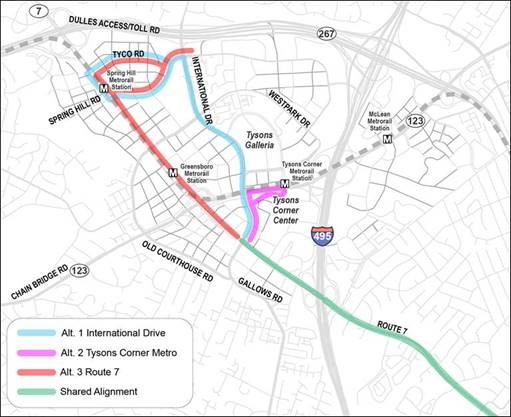
The Fairfax County Board of Supervisors has approved a bus rapid transit (BRT) route through the heart of Tysons, despite some concerns that it might not be as “express” as hoped.
Fairfax County started studying options for BRT through Tysons three years ago as part of a regional push to establish a bus line between Tysons and the Mark Center in Alexandria.
After reviewing several alternative routes, the board voted on Tuesday (July 27) to approve county staff’s recommendation for a route that will run from the Spring Hill Metro station up to International Drive and from there down to Route 7 past Tysons Galleria and Tysons Corner Center.
“The outreach on this plan was very well done, very thoughtful, and working with our transit associations,” Providence District Supervisor Dalia Palchik said. “I think this has had robust input from our community…This is going to be best for businesses in Tysons and for our pedestrians and cyclists.”
One concern raised at the board meeting by Springfield District Supervisor Pat Herrity is that the route won’t have pull-off spots that will allow for both express buses that run directly between major points without interruption and local buses that would make more frequent stops within Tysons.
“I think we’re really short changing ourselves not doing the local stops, where they pull off, so we can run express [buses] on it,” Herrity said. “I think long term, we’re going to be sorry for that.”
Herrity abstained from the final vote, saying he supported the project overall but had concerns about its structure.
Chairman Jeff McKay said the existing configuration represented a compromise between the need for better transit and respecting the right-of-way limitations in Tysons.
“Right of way is at a premium,” McKay said. “The impact to our businesses and impacts to our residents on the right-of-way needs of these projects is significant and significantly challenging.”
With the route approved, the Tysons BRT route will be incorporated into the Northern Virginia Transportation Commission’s broader Envision Route 7 study, which is currently in its fourth and final phase.
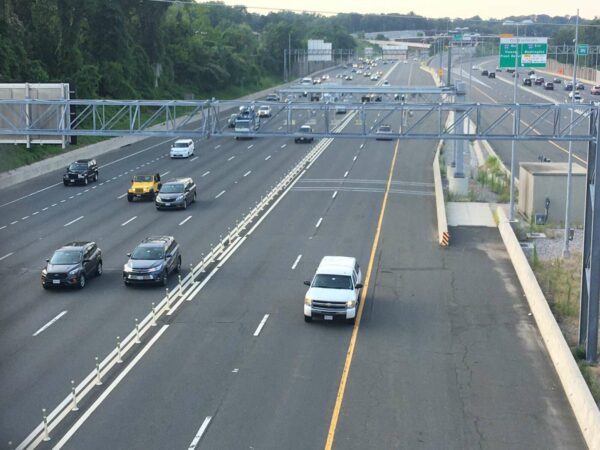
Virginia is reconsidering the future of funding for transportation infrastructure, as the rise of electric and more fuel-efficient vehicles has cut into the gas tax revenue that helps pay for those projects.
One option the Commonwealth has started pursuing is a “mileage-based user fee” that drivers would pay depending on how much or little they travel. Drivers could opt into the voluntary system in lieu of paying a mandatory highway use fee that first took effect on July 1, 2020.
State Sen. Janet Howell (D-32nd District) says the highway use fee — which applies to cars that average at least 25 miles per gallon and is calculated based on the fuels tax at the time of a vehicle’s registration and the average number of miles it travels in the state — is a precursor to Virginia’s planned mileage-based user fee program.
“For most of the past decade, Virginia, like the rest of the country, has been wrestling with the challenge of identifying the best approach to generating sufficient revenues to support transportation investments,” she said in a statement. “As cars have become more fuel efficient and electric vehicle adoption increases, it is increasingly difficult to strike the right balance of raising adequate revenues from traditional sources and adhering to a usage-based philosophy of highway financing.”
The Virginia Department of Motor Vehicles is currently fielding requests from private contractors to operate the program, which it anticipates rolling out in July 2022. Led by the DMV, a workgroup tasked with developing the program is slated to deliver an interim report to the Commonwealth this December.
The working group is identifying all requirements to Virginia’s mileage-based user fee program with “a priority on consumer privacy protection and equity,” DMV spokesperson Jessica Cowardin said in a statement.
Seeking new ways to fund road repairs and transit projects, Virginia established the mileage-based fee program in April 2020 when the General Assembly adopted a major transportation bill that also established the highway use fee and raised gas taxes for the first time in more than three decades.
The bill also lowered vehicle registration fees by $10 and repealed an annual $64 fee for electric and alternative fuel vehicles.
The changes, which include tying the gas tax rate to the Consumer Price Index to keep up with inflation starting next year, will help Virginia diversify its funding sources to offset stagnant or declining gas tax revenue, state legislators say.
The consultant KPMG previously estimated that Virginia would lose nearly 33% of its gas tax revenues by 2030 due to fuel efficiency, or approximately $260 million.
“Neither the [Highway Use Fee] nor the EV Registration fee are intended to suppress the sales of fuel efficient or electric vehicles, but simply recapture the average annual revenue from the foregone gas taxes,” Howell said.
The idea of taxing drivers based on how much they travel instead of the fuel they use has been gaining traction throughout the U.S. over the past decade.
Despite inflation, the federal gas tax rate has been locked in at 18.4 cents per gallon since it went up from 14.1 cents in 1993, meaning there’s less money to fund highway improvements.
“Many cars are not using gas at all, such as electric, so that system of highway finance has been coming apart for a long time,” said Jonathan Gifford, director of George Mason University’s Center for Transportation Public-Private Partnership Policy in Arlington.
If Virginia wants to encourage a transition to clean energy and electric vehicles, which “is absolutely essential to addressing climate change, we will need to look to other options” to pay for transportation projects, Northern Virginia Transportation Alliance President Jason Stanford says. Read More
Virginia’s plan to extend the I-495 Express Lanes to the George Washington Memorial Parkway in McLean, just south of the American Legion Bridge, is now one step closer to becoming a reality after the project received key federal approvals late last week.
The Federal Highway Administration (FWHA) and National Park Service (NPS) both determined that the I-495 Express Lanes Northern Extension (495 NEXT) project would have no significant environmental impact based on an assessment submitted by the Virginia Department of Transportation, which announced the news on Friday (July 9).
FHWA also approved the project’s interchange justification report, which analyzed the potential traffic impacts.
The approvals allow VDOT to move forward with the design and construction process, even as many community members and local elected officials remain skeptical that the project should advance with Maryland’s Capital Beltway expansion plans in limbo.
“This is an essential step toward bringing relief and multimodal solutions to a section of I-495 that faces daily congestion and unreliability,” VDOT Deputy Commissioner Rob Cary said in the news release. “We are appreciative of the collaboration and partnership from our federal partners, as we work together to implement the best possible solutions to improve travel on the Capital Beltway and in our region.”
Signed on June 29, the FWHA Finding of No Significant Impact (FONSI) considered the project’s implications for surrounding communities, land use, historic properties, water and air quality, noise, and other factors.
The report says building the proposed three-mile toll lanes extension “could result in short-term reduced water quality, floodplain impacts, and forest and wetland impacts,” but the impacts could be minimized with “the implementation of state-mandated best management practices and conformance with current stormwater regulations.”
“Overall cumulative effects of the project are not expected to be significant,” FWHA says in the report. “In addition, current regulatory requirements and planning practices help to avoid or minimize the contribution of present and future actions to adverse cumulative effects for socioeconomic, natural, and historic resources.”
According to the NPS FONSI approved on June 7, 495 NEXT would permanently affect 0.9 acres of George Washington Memorial Parkway because land is needed to tie the project into the existing interstate near the American Legion Bridge. 1.3 acres of park land would be temporarily affected during construction, including the clearing of forest canopy and plants.
Still, the park service concluded the impacts will be minimal compared to the anticipated benefits of the project, which VDOT says will reduce traffic congestion, improve trip reliability, and support more travel options, with the addition of a shared-use path from Lewinsville Road to Live Oak Drive and bus service between Virginia and Maryland.
“The Build Alternative will result in both beneficial and/or adverse impacts on the Park,” the NPS said. “However, the NPS has determined that the Build Alternative can be implemented without significant adverse effects.” Read More


